Your home must meet strict new insulation standards by 2025, with U-values of 0.15 W/m²K for roofs, 0.18 W/m²K for walls, and 0.11 W/m²K for floors. You’ll need minimum 270mm mineral wool thickness in lofts and 150mm cavity wall fills to comply. Start by checking your property’s current EPC rating through the government’s official register, then create a five-year improvement plan using available grants like the Green Homes Grant. Our extensive guide outlines your next strategic steps.
Key Takeaways
- New 2025 regulations require U-values of 0.15 W/m²K for roofs, 0.18 W/m²K for walls, and 0.11 W/m²K for floors.
- Check your property’s current energy efficiency using the free EPC checker through the government’s official register.
- Minimum insulation requirements include 270mm mineral wool for lofts and 150mm cavity wall filling.
- Government support schemes offer up to £5,000 through Green Homes Grant and full funding via ECO4 for eligible households.
- Develop a five-year improvement plan incorporating mandatory energy audits and strategic upgrades to meet 2025 standards.
Key Changes in the 2025 Building Regulations: What Homeowners Need to Know
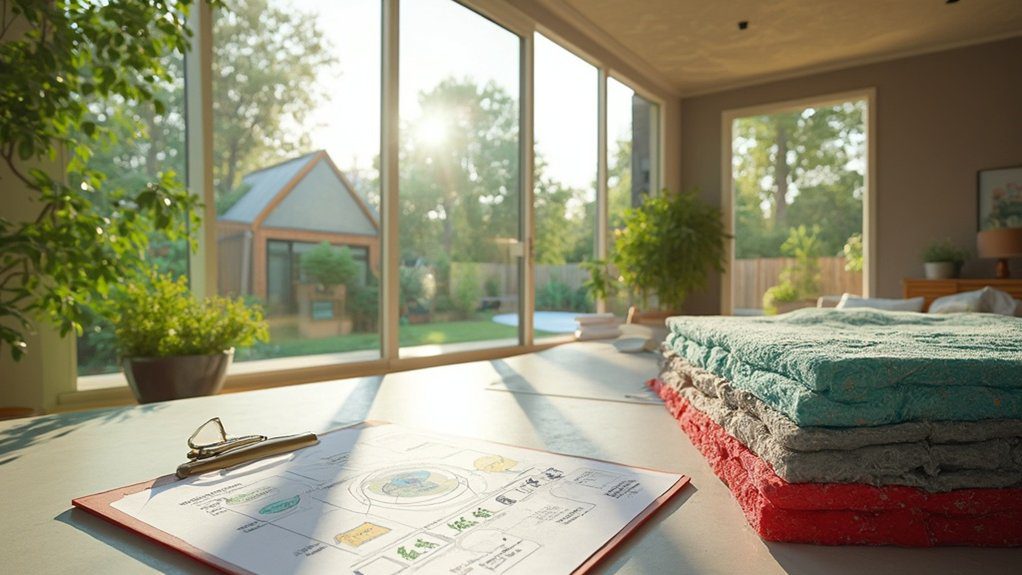
Three major changes to building regulations in 2025 will considerably impact how you’ll need to insulate and ventilate your home.
First, you’ll be required to upgrade your insulation materials to meet stricter U-value standards, ensuring better thermal performance throughout your property. This includes walls, roofs, and floors using approved building materials that meet the new specifications.
Second, you’ll need to schedule mandatory energy audits every five years to verify your home’s compliance with updated efficiency standards. These assessments will measure heat loss, air tightness, and overall energy performance.
Third, you’ll have to install smart ventilation systems that balance air quality with heat retention.
These systems will work in tandem with your insulation upgrades to create a more energy-efficient living space while maintaining healthy indoor air quality.
Understanding Your Home’s Current Energy Performance Certificate (EPC)
To effectively plan your home’s compliance with the 2025 regulations, you’ll first need to analyze your current Energy Performance Certificate (EPC).
Your EPC rating, ranging from A (most efficient) to G (least efficient), provides essential insights into your property’s energy performance and highlights specific areas requiring improvement.
You can access your property’s EPC through the government’s official register or request a new assessment if yours is over 10 years old.
Pay special attention to the recommendations section, which outlines practical steps to enhance your home’s energy efficiency.
This document details your property’s current insulation levels, heating system efficiency, and window glazing performance.
Understanding these elements helps you identify priority upgrades needed to meet future standards and potentially avoid non-compliance penalties while reducing your energy costs.
New Insulation Requirements: Breaking Down the Technical Standards

Building on your EPC assessment, the 2025 regulations introduce specific technical benchmarks for home insulation that you’ll need to meet.
The new standards require U-values of 0.15 W/m²K for roofs, 0.18 W/m²K for walls, and 0.11 W/m²K for floors in existing properties.
To achieve these technical specifications, you’ll need to upgrade your insulation materials strategically.
The regulations now demand mineral wool thickness of at least 270mm for lofts, while cavity walls must achieve a minimum fill of 150mm with approved materials.
Floor insulation requires PIR boards at 100mm thickness beneath suspended timber or concrete surfaces.
These standards align with the government’s net-zero targets and match what many of your neighbors are already implementing to future-proof their homes and reduce energy costs.
Cost Implications and Available Government Support Schemes
While meeting the new insulation standards requires significant upfront investment, homeowners can offset these costs through various government initiatives.
Your cost analysis should factor in both immediate expenses and long-term savings on energy bills. You’ll find the Green Homes Grant scheme particularly valuable, offering vouchers up to £5,000 for insulation improvements.
Government incentives also include the ECO4 scheme, which provides full funding for eligible low-income households.
You’re encouraged to explore the Boiler Upgrade Scheme if you’re considering heat pumps alongside insulation upgrades. Additionally, you’ll benefit from reduced VAT rates on energy-saving materials.
Before starting your insulation project, check your eligibility for local authority grants. Many councils offer supplementary support schemes that complement national programs, maximizing your potential savings.
Step-by-Step Guide to Assessing Your Property’s Compliance

Before undertaking any insulation upgrades, you’ll need to conduct a systematic evaluation of your property’s current compliance status.
Start by downloading our thorough compliance checklist, which covers all critical areas of building regulations for insulation standards.
Your property assessment should follow these key steps:
- Review your existing Energy Performance Certificate (EPC)
- Measure your current insulation thickness in walls, roof, and floors
- Check window and door U-values
- Document heating system efficiency
- Identify thermal bridges and air leakage points
Once you’ve gathered this data, compare your findings against current regulations.
Pay special attention to minimum U-values and insulation requirements for your property type.
If you’re unsure about technical measurements, we recommend hiring a certified assessor to guarantee accurate compliance evaluation.
Essential Home Improvements to Meet the 2025 Standards
To meet the upcoming 2025 building regulations, you’ll need to implement several key improvements that greatly boost your home’s energy performance.
Fellow homeowners across the UK are already taking action to guarantee compliance and reduce their energy costs through strategic upgrades.
- Install extensive insulation upgrades, including cavity wall filling, loft insulation reaching 270mm thickness, and floor insulation where applicable.
- Replace outdated heating systems with high-efficiency alternatives like air source heat pumps or condensing boilers rated 92% or higher.
- Upgrade to energy efficient appliances that meet A+++ ratings, particularly focusing on heating, cooling, and major household equipment.
- Install smart monitoring systems to track energy usage and optimize consumption patterns through automated controls.
These improvements won’t just guarantee compliance—they’ll position your property at the forefront of energy efficiency standards while reducing operating costs.
How the New Regulations Affect Property Values and Sales

The new building regulations have created a notable shift in UK property market dynamics.
You’ll find that homes meeting or exceeding the latest insulation standards now command premium prices, while non-compliant properties face significant value depreciation. Current market trends show buyers actively seeking energy-efficient homes to avoid future upgrade costs.
Your property valuation will increasingly depend on your home’s energy performance.
Properties with high EPC ratings typically sell 14% faster and achieve better prices than less efficient counterparts.
If you’re planning to sell, you’ll need to demonstrate compliance with the new standards or adjust your asking price to account for necessary upgrades.
Common Compliance Challenges and Practical Solutions
While meeting new insulation standards presents several key challenges, most property owners face three primary hurdles: limited cavity wall access, insufficient loft clearance, and listed building restrictions.
You’ll find practical solutions to these common compliance pitfalls by following expert-tested approaches that work for UK homes like yours.
- For tricky cavity walls, consider external wall insulation systems (EWI) as an alternative – they’re especially effective for solid-wall properties.
- Address loft clearance issues by using slim-profile insulation materials or raising the floor level with adjustable platforms.
- Navigate listed building restrictions by working with conservation-approved materials and consulting heritage specialists early.
- Implement a phased approach to spread costs while maintaining compliance deadlines – start with quick wins like draught-proofing and pipe insulation.
Expert Tips for Long-Term Energy Efficiency Planning

Planning ahead for energy efficiency upgrades can dramatically reduce your property’s long-term operating costs and carbon footprint. Start by scheduling professional energy audits to identify your home’s specific improvement needs and establish a clear timeline for implementing changes.
You’ll want to prioritize upgrades based on their return on investment and environmental impact. Consider installing sustainable materials like recycled insulation and energy-efficient windows during your next renovation.
When you’re mapping out improvements, focus on creating an extensive five-year plan that aligns with building regulations and your budget.
Don’t forget to factor in future technologies and emerging standards. Track your energy consumption patterns and adjust your strategy accordingly.
Frequently Asked Questions
Can I Get a Temporary Exemption if I’m Planning Major Renovations Soon?
You can’t get temporary exemptions just for planned renovations, but you’ll want to coordinate your insulation upgrades with your renovation timeline to maximize efficiency and minimize disruption to your home improvement project.
What Happens if Previous Homeowners Made Unauthorized Insulation Modifications?
“What’s done is done,” but you’re still responsible. You’ll need to verify your home’s insulation compliance through a certified inspector. If unauthorized modifications exist, you’ll need to bring them up to current standards.
Do Listed Buildings Have Different Deadlines for Meeting the New Regulations?
Yes, you’ll find listed building guidelines provide specific exemptions and extended renovation timelines. You’re not bound by standard deadlines, but you’ll need to work with conservation officers to implement energy-efficient solutions that respect heritage.
Are There Specific Requirements for Homes With Unique Architectural Features?
You’ll need special insulation options that protect your home’s architectural integrity. Consider secondary glazing, internal wall treatments, and bespoke solutions designed specifically for unique features while maintaining compliance with energy standards.
Can I Transfer My Current EPC Rating When Moving to Another Property?
Did you know 40% of homeowners misunderstand EPC transfers? You can’t transfer your current EPC rating – each property needs its own assessment, as unique features and conditions affect energy performance differently during the moving process.
Conclusion
While you might worry about the initial costs of meeting 2025’s stricter building regulations, you’ll actually save money through reduced energy bills and increased property value. Your home’s energy efficiency isn’t just about compliance – it’s an investment in lower operating costs and environmental sustainability. Don’t wait until the deadline; start planning your upgrades now to spread costs and guarantee you’re fully compliant with the new technical standards.

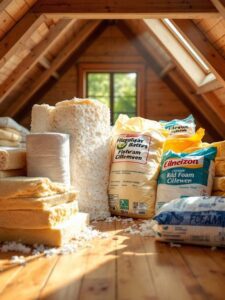
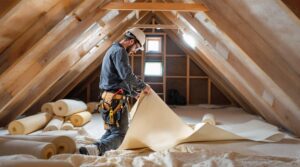

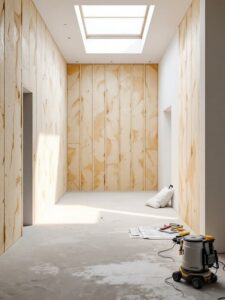



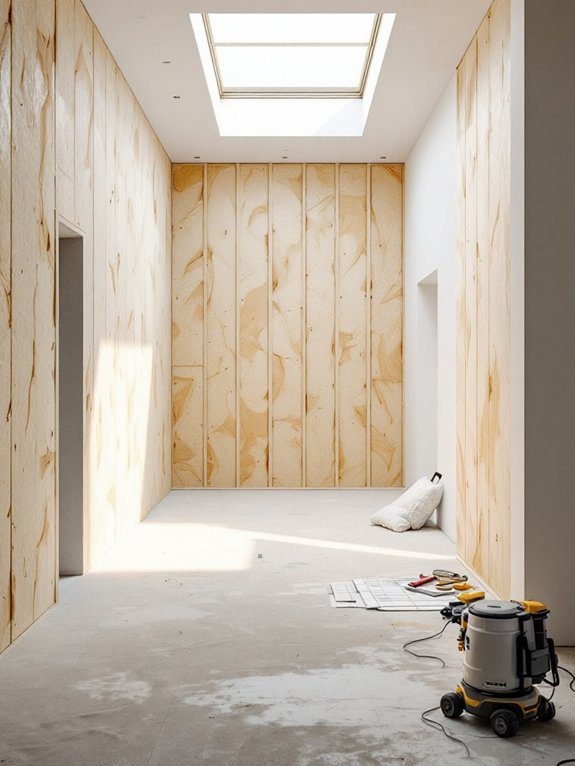
4 Responses
I haven’t checked in here for some time as I thought it was getting boring, but the last few posts are good quality so I guess I will add you back to my everyday bloglist. You deserve it my friend 🙂
Hello, Neat post. There’s a problem with your web site in internet explorer, would test thisK IE still is the marketplace leader and a huge portion of other folks will pass over your magnificent writing due to this problem.
Attractive section of content. I just stumbled upon your weblog and in accession capital to assert that I get in fact enjoyed account your blog posts. Anyway I will be subscribing to your augment and even I achievement you access consistently rapidly.
Plunge into the vast universe of EVE Online. Shape your destiny today. Conquer alongside hundreds of thousands of explorers worldwide. Join now